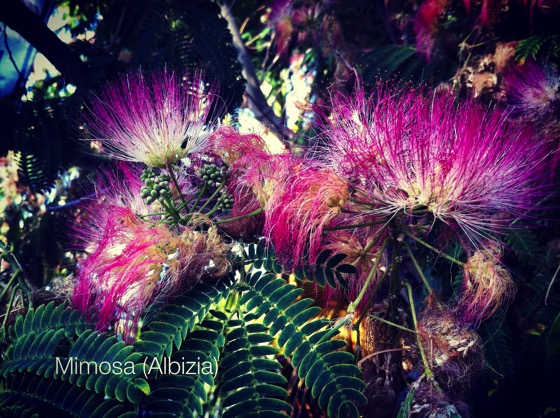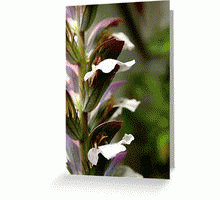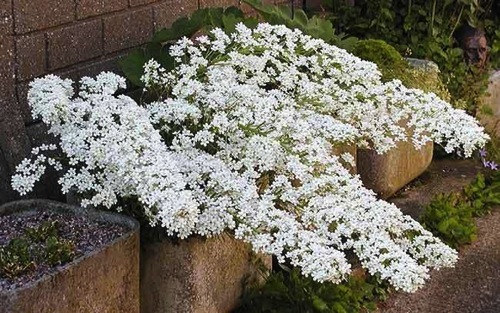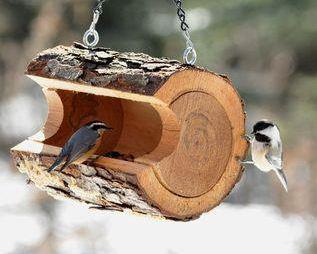Garden Alphabet: Mimosa (Albizia julibrissin)

The genus is named after the Italian nobleman Filippo degli Albizzi, who introduced it to Europe in the mid-18th century, and it is sometimes incorrectly spelled Albizzia. The specific epithet julibrissin is a corruption of the Persian word gul-i abrisham (گل ابریشم) which means “silk flower” (from gul گل “flower” + abrisham ابریشم “silk“).
Albizia julibrissin is known by a wide variety of common names, such as Persian silk tree or pink siris. It is also called Lenkoran acaciaor bastard tamarind, though it is not too closely related to either genus. The species is usually called “silk tree” or “mimosa” in the United States, which is misleading – the former name can refer to any species of Albizia which is most common in any one locale. And, although once included in Mimosa, neither is it very close to the Mimoseae. To add to the confusion, several species of Acacia, notablyAcacia baileyana and Acacia dealbata, are also known as “mimosa” (especially in floristry), and many Fabaceae trees with highly divided leaves are called thus in horticulture.
Its leaves slowly close during the night and during periods of rain, the leaflets bowing downward; thus its modern Persian nameshabkhosb (شبخسب) means “night sleeper” (from shab شب “night” and -khosb خسب “sleeper”). In Japan its common names arenemunoki, nemurinoki and nenenoki which all mean “sleeping tree”. Nemu tree is a partial translation of nemunoki. — Wikipedia
Get my photos a variety of products including tote bags, mugs, posters and more!
More information on Mimosa (Albizia julibrissin):
- Mimosa (Albizia julibrissin) on Wikipedia
- Mimosa (Albizia julibrissin) at Missouri Botanical Garden
- Mimosa (Albizia julibrissin) at Fine Gardening
- Mimosa (Albizia julibrissin) at Dave’s Garden
* A portion of each sale from Amazon.com directly supports my blogs
** Many of these books may be available from your local library. Check it out!
Previously in Garden Alphabet:
- Acanthus
- Agapanthus (Lily of the Nile)
- Agave americana
- Amaryllis
- Apricot (Prunus armeniaca)
- Aspen
- Azalea
- Banana
- Basil
- Bird of Paradise (Strelitzia)
- Bonsai
- Bougainvillea
- Brugmansia
- Butterfly (Lepidoptera)
- California Flannelbush (Fremontodendron californicum)
- California Poppy (Eschscholzia californica)
- Calla Lily (Zantedeschia aethiopica)
- Campsis radicans
- Castor Bean (Ricinus)
- Caltapa
- Chives (Allium schoenoprasum)
- Clematis
- Camellia
- Currant (Ribes)
- Dahlia
- Datura
- Japanese Cherry (Prunus serrulata)
- Daffodil (Narcissus)
- Dietes (Fortnight Lily)
- Dudleya
- Echinacea
- Ecualyptus
- Epiphyllum
- Poinsettia (Euphorbia pulcherrima)
- Ficus benjamina
- Freesia
- Fungi
- Geranium
- Gerbera Daisy
- Grape (Vitis vinifera)
- Helianthus (sunflower)
- Hibiscus (Malvaceae)
- Hollyhock (Alcea)
- Honeybee
- Hosta
- Common Ice Plant (Mesembryanthemum crystallinum)
- Iris
- Jacaranda mimosifolia
- Joshua Tree (Yucca brevifolia)
- Kniphofia “Red Hot Poker”
- Lantana
- Lavender (Lavendula)
- Kousa Dogwood (Cornus kousa)
- Magnolia x soulangeana (Saucer Magnolia/Tulip Tree)
- Mandevilla
- Magnolia Grandiflora
- Marigold (Calendula officinalis)
- Matilija Poppy (Romneya)
- Morning Glory (Convolvulaceae)
- Nandina
- Oleander (Nerium)
- Oleander (Nerium)
- Olive
- Orange
- Orchid from the Southern California Spring Garden Show 2013
- Oriental Poppy (Papaver orientale)
- Polygonatum (Solomon’s Seal)
- Paperwhites
- Pineapple (Ananas comosus)
- Primula (Primrose)
- Queen Anne’s Lace (Daucus carota)
- Rosa ‘JFK’
- Rosa ‘Mikado’
- Rudbeckia
- Salvia
- Sempervivum
- Snow Plant (Sarcodes sanguinea)
- Squirrel
- Star Jasmine (Trachelospermum jasminoides)
- Succulents
- California Sycamore (Platanus racemosa)
- Sweet Potato (Ipomoea batatas)
- Tomato
- Vinca
- Water Lily (Nymphaeaceae)
- Wisteria
- Zinnia





